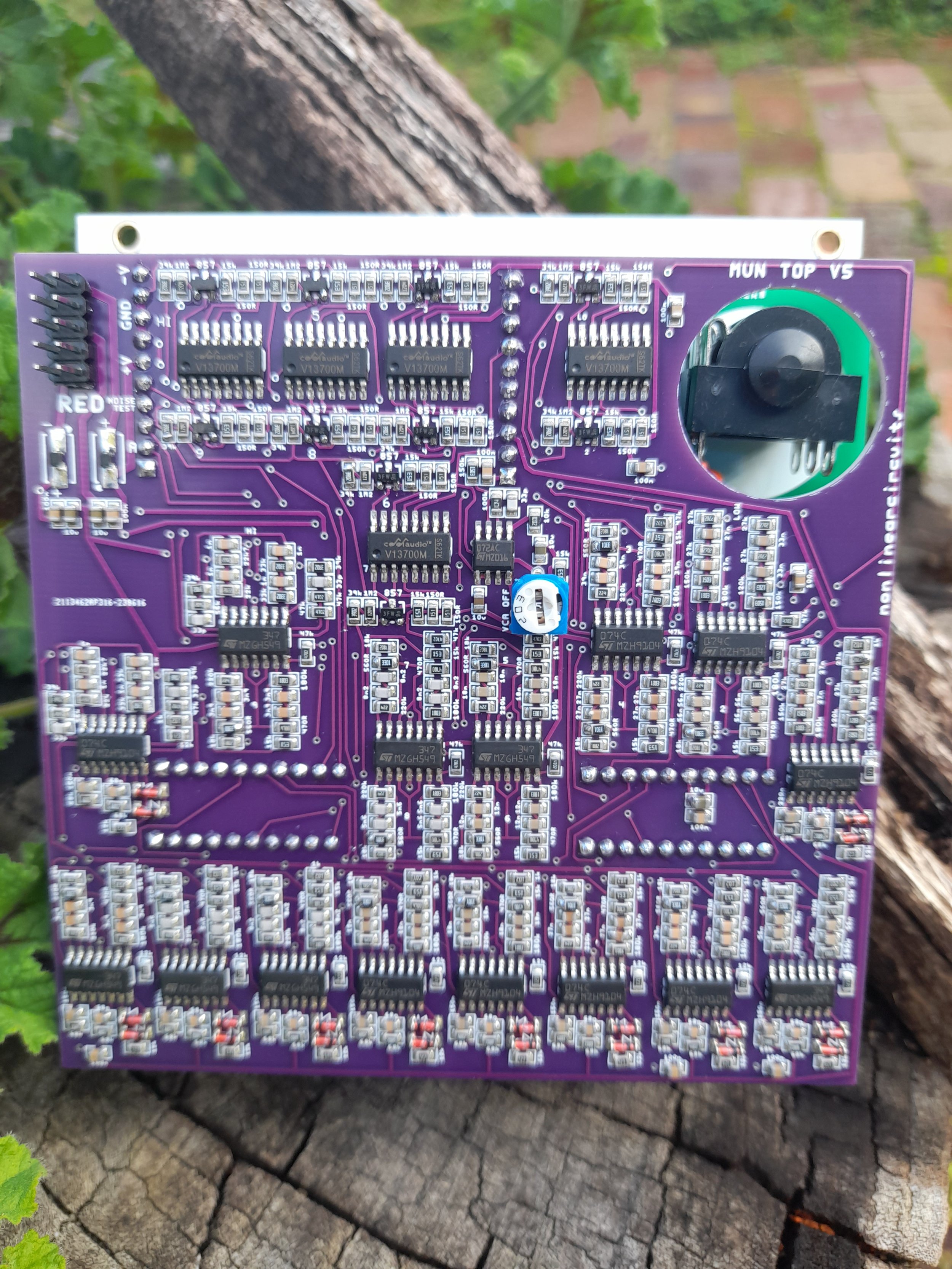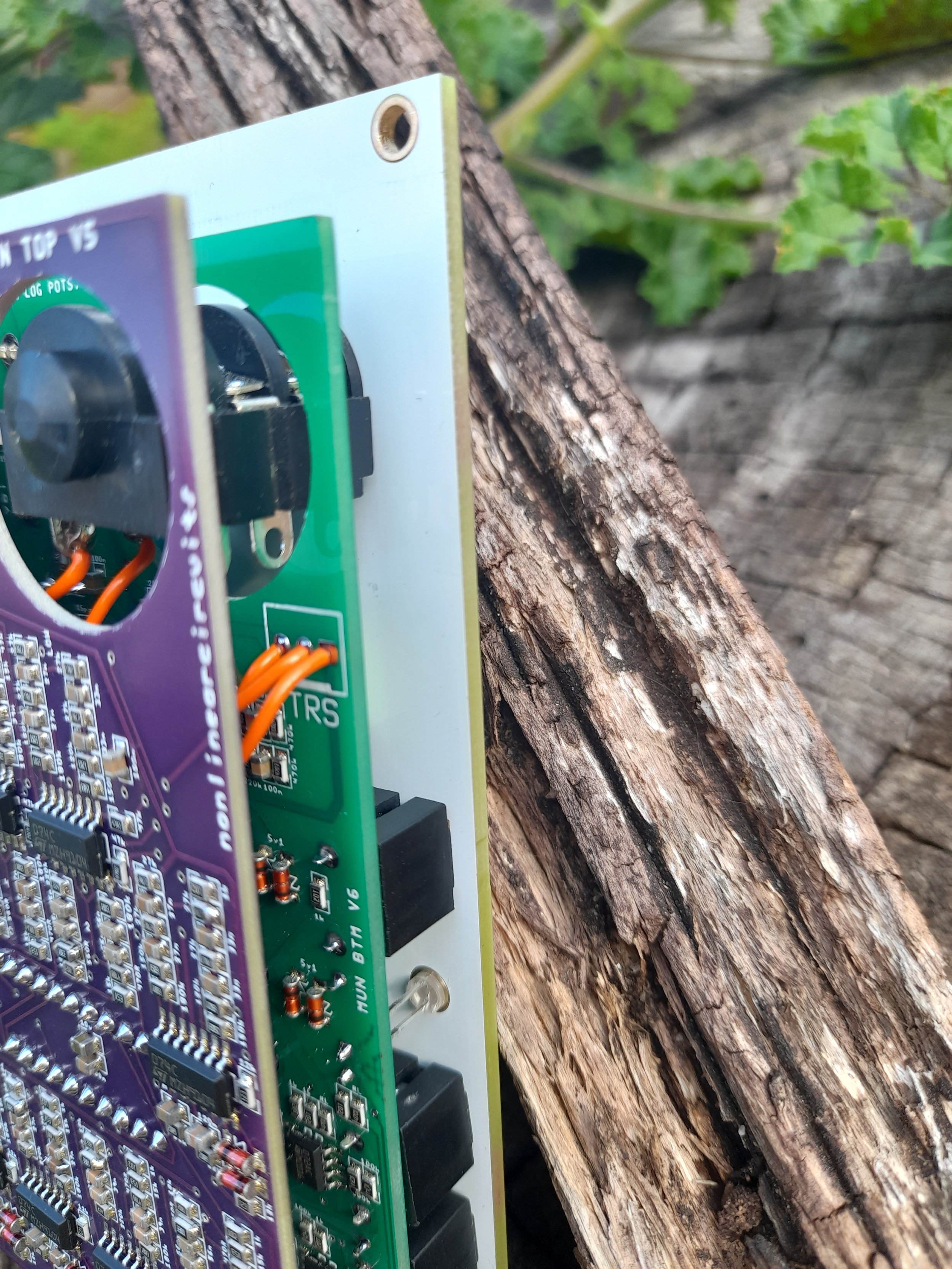MUN (vocoder)
Description/Usage
22hp
This module is a 22HP 10 channel vocoder based on the Syntovox 222. I own a 222 and have always been impressed with the sound and elegant design, so it was an easy choice of where to start.
The initial design for this module was 42HP with all the fruit – variable envelope lengths, envelope outputs and inputs, filter outputs and inputs, pause stuffing, external noise input, separate carriers for odd/even channels, etc. and it sucked; way too finicky to use.
So I stripped it back to a more minimal version and am much happier with it.
For the Voice section, there is a TRS/mono 6.35mm input for mics, a stereo/mono 3.5mm input for line level sources and a synth level input.
The Carrier section has a synth level input only.
There is no voice/unvoiced switching. Noise from a transistor based source is mixed with the Carrier signal on channels 9 & 10. Pots can control the noise level and the colour (pink/white).
There are jacks for each frequency channel and the envelopes generated. You can also patch in signals to stimulate the carrier signal on the corresponding channel.
On the 1st batch of panels the screw holes on the left side are a bit out. The ones on the right side are correct, but the ones on the left will only fit if you use sliding nuts or do a bit of milling/drilling. These will be sold as B stock panels.
DIY
Description/Usage
22hp
This module is a 22HP 10 channel vocoder based on the Syntovox 222. I own a 222 and have always been impressed with the sound and elegant design, so it was an easy choice of where to start.
The initial design for this module was 42HP with all the fruit – variable envelope lengths, envelope outputs and inputs, filter outputs and inputs, pause stuffing, external noise input, separate carriers for odd/even channels, etc. and it sucked; way too finicky to use.
So I stripped it back to a more minimal version and am much happier with it.
For the Voice section, there is a TRS/mono 6.35mm input for mics, a stereo/mono 3.5mm input for line level sources and a synth level input.
The Carrier section has a synth level input only.
There is no voice/unvoiced switching. Noise from a transistor based source is mixed with the Carrier signal on channels 9 & 10. Pots can control the noise level and the colour (pink/white).
There are jacks for each frequency channel and the envelopes generated. You can also patch in signals to stimulate the carrier signal on the corresponding channel.
On the 1st batch of panels the screw holes on the left side are a bit out. The ones on the right side are correct, but the ones on the left will only fit if you use sliding nuts or do a bit of milling/drilling. These will be sold as B stock panels.
DIY
Description/Usage
22hp
This module is a 22HP 10 channel vocoder based on the Syntovox 222. I own a 222 and have always been impressed with the sound and elegant design, so it was an easy choice of where to start.
The initial design for this module was 42HP with all the fruit – variable envelope lengths, envelope outputs and inputs, filter outputs and inputs, pause stuffing, external noise input, separate carriers for odd/even channels, etc. and it sucked; way too finicky to use.
So I stripped it back to a more minimal version and am much happier with it.
For the Voice section, there is a TRS/mono 6.35mm input for mics, a stereo/mono 3.5mm input for line level sources and a synth level input.
The Carrier section has a synth level input only.
There is no voice/unvoiced switching. Noise from a transistor based source is mixed with the Carrier signal on channels 9 & 10. Pots can control the noise level and the colour (pink/white).
There are jacks for each frequency channel and the envelopes generated. You can also patch in signals to stimulate the carrier signal on the corresponding channel.
On the 1st batch of panels the screw holes on the left side are a bit out. The ones on the right side are correct, but the ones on the left will only fit if you use sliding nuts or do a bit of milling/drilling. These will be sold as B stock panels.




